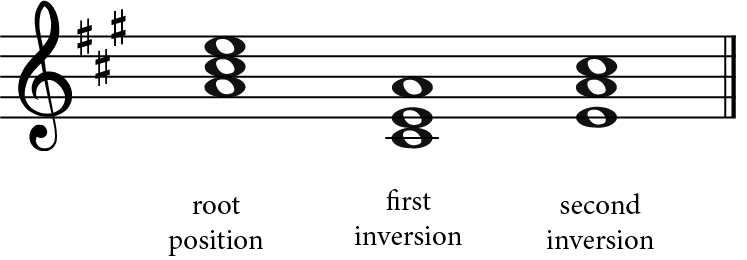In the ABRSM Grade 5 Music Theory exam students need to know chords created from the 1st, 2nd, 4th and 5th degrees of the scale. Scales can have up to six sharps and flats and chords using minor scales are included too.
Students also need to be able to recognise the root position, 1st inversion and 2nd inversion of any of these chords.
To help you with Grade 5 Music Theory chords we have some example chords from two different keys – A Major and F Minor.
Need more help with Grade 5 music theory? Check our guide to acing your grade 5 exam.
A Major Chords
Degrees of the scale
Here are the degree of A Major. There are rules for using capitals and lowercase Roman numerals, but these are not necessary to know for Grade 5.

Chords on the 1st, 2nd, 4th and 5th notes.
Here are the chords you need to be able to work out in A Major. See how each chord is made up of a triad (1st/3rd/5th) above the root note and all the notes are in the scale of A Major.

Inversions
Below we have written out the root position, 1st inversion and 2nd inversion of Chord I in A Major.

As you can see from the image, to make the 1st inversion we have the 2nd note in the triad (C#) as the lowest note. For the second inversion, the third note in the triad (E) is the lowest note in the chord. The order of the higher two notes does not matter, so we could have C#, A, E for the first inversion Chord I.
We can also write the chord lower on the stave, as long as the lowest notes are E (for the 1st inversion) or C# (for the 2nd inversion).

F Minor Chords
F Minor is the relative minor of Ab Major and so the natural minor scale will have four flats (Bb, Eb, Ab, Db).
Degrees of the scale
The degrees of the scale work the same whichever scale you are using.

Chords on the 1st, 2nd, 4th and 5th notes.
In the same way as the Major example, the chords of F Minor are created with triads using the notes of the F Minor scale.

Inversions
Here are the root position, 1st inversion and 2nd inversion for chord I in F Minor.

Naming the Notes of the Scale
It is also really useful to know the names of each note of the scale. This way you can ‘write out the chord on the subdominant note of G Major’. And answer similar questions.
- 1st = tonic
- 2nd = supertonic
- 3rd = mediant
- 4th = subdominant
- 5th = dominant
- 6th = submediant
- 7th = leading note

Are there a lot of Grade 5 Music Theory Chords?
At first glance this might seem true. You need to know the 1st, 2nd, 4th and 5th chords of any major or minor scale….and their inversions! So that’s 12 Major…..12 Minor……three inversions……makes 72 chords! Definitely seems like a lot.
The thing is, you don’t actually have to memorise these chords, so long as you know how to work them out. But in order to do this quickly, I recommend that you do some practice questions and make sure you can recall the major/minor key signatures lightning fast.
More on Grade 5 Music Theory
Need more support preparing for Grade 5 Music theory, check out our complete guide here. We also have a more information on the other concepts you need to know for Grade 5. And if you want to test your skills take our free Grade 5 Quiz.
